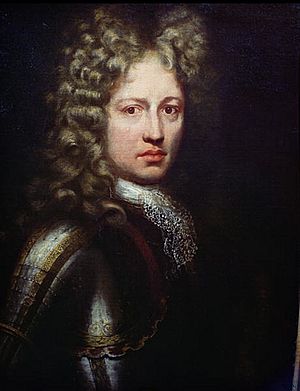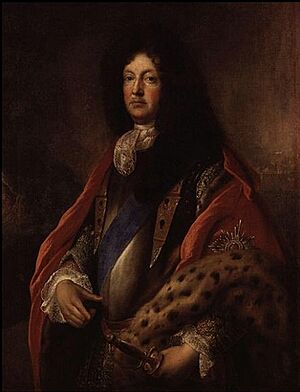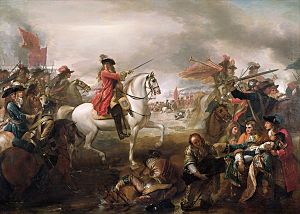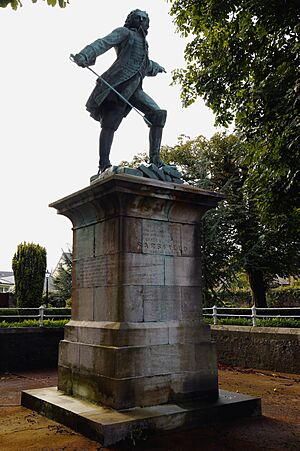Patrick Sarsfield, 1st Earl of Lucan facts for kids
Quick facts for kids
Patrick Sarsfield, 1st Earl of Lucan
|
|
|---|---|

Portrait traditionally identified as Sarsfield, Franciscan Library, Killiney
|
|
| MP County Dublin | |
| In office May 1689 – August 1689 |
|
| Monarch | James II |
| Personal details | |
| Born | c. 1655 |
| Died | 21 August 1693 Huy, Belgium |
| Nationality | Irish |
| Spouse | Honora Burke |
| Children | James Sarsfield, 2nd Earl of Lucan |
| Occupation | Soldier |
| Military service | |
| Allegiance | |
| Rank | Lieutenant General |
| Battles/wars | Third Anglo-Dutch War Franco-Dutch War Entzheim; Turckheim; Salzbach; Altenheim Monmouth Rebellion Battle of Sedgemoor Glorious Revolution Wincanton Skirmish Williamite War in Ireland The Boyne; Limerick 1690; Aughrim; Limerick 1691 Nine Years' War Steenkerque; Landen |
Patrick Sarsfield, 1st Earl of Lucan (born around 1655 – died 21 August 1693), was a famous Irish soldier. He was a key leader in the Jacobite army during the Williamite War in Ireland. This war took place from 1689 to 1691.
Sarsfield came from a rich Catholic family. He joined the army in 1672. This was during the Third Anglo-Dutch War, which was part of the larger Franco-Dutch War. After England stopped fighting, his army unit served in France. When the war ended in 1678, he went back to England. For a time, Catholics were not allowed in the English military.
When the Catholic King James II became king in 1685, Sarsfield joined the Royal Army. He helped put down a rebellion led by the Duke of Monmouth. By November 1688, he was a colonel. When King James was removed from power in the Glorious Revolution, Sarsfield stayed loyal. He followed James to France. In March 1689, he returned to Ireland. He became a senior commander in the Jacobite army. He was also elected to the Patriot Parliament.
By late 1690, Sarsfield was a main leader of the "War Party." This group wanted to keep fighting. He was given the title Earl of Lucan. After the Battle of Aughrim in July 1691, the Jacobite army's situation was very difficult. Sarsfield helped to make the Treaty of Limerick. This agreement ended the war. As part of the treaty, thousands of Irish soldiers went to France. This event is known as the "Flight of the Wild Geese." Many of these soldiers, including Sarsfield, fought in the Nine Years' War. Sarsfield was killed in battle at Battle of Landen in 1693.
People at the time agreed he was very brave. However, they had different ideas about his judgment and intelligence. Still, his bravery and death made him a hero in Ireland. He was also remembered by Irish people living in other countries.
Contents
Patrick Sarsfield's Early Life and Family
The Sarsfield family were rich Catholic merchants from Dublin. They were originally from England. Sir William Sarsfield, an ancestor, was knighted in 1566. He bought Lucan Manor, a large estate near Dublin.
Sarsfield's father, Patrick, was born around 1628. He married Anne O'Moore. Anne's father, Rory O'Moore, was an important Irish noble. He played a big part in the Irish Rebellion of 1641. Sarsfield's father fought for the Catholic side in the Irish Confederate Wars. His lands were taken away in 1652 but given back in 1662.
In 1689, Sarsfield married Honora Burke. She was 15 years old. They had one son, James Sarsfield, 2nd Earl of Lucan. After Sarsfield died, Honora married James FitzJames, 1st Duke of Berwick. He was the son of King James II.
Some people thought Catalina Sarsfield was Sarsfield's daughter. She was a queen of the short-lived Kingdom of Corsica. But she was actually a distant cousin.
Military Career in France and England

We don't know much about Sarsfield's early life. He probably grew up on his family's land at Tully. There is no proof he went to a French military school.
In 1670, England agreed to help France attack the Dutch Republic. England would send 6,000 soldiers. When the Franco-Dutch War started in 1672, Sarsfield joined the army. He was part of a unit led by the Duke of Monmouth. When England left the war in 1674, Sarsfield's unit stayed in France. He fought in battles like Entzheim and Turckheim. He was also at Salzbach in 1675 when his commander was killed.
Sarsfield stayed in France until the war ended in 1678. Then he returned to London. He tried to join a new army unit. But he was caught up in the Popish Plot. This was a made-up story about Catholics planning to kill the king. Because of this, Catholics like Sarsfield were not allowed to serve in the military.
When King James, a Catholic, became king in 1685, Sarsfield's career improved. He helped stop the Monmouth Rebellion. He was hurt at the Battle of Sedgemoor. By 1688, he was a colonel in charge of a cavalry unit.
In 1687, Richard Talbot, 1st Earl of Tyrconnell, became the King's representative in Ireland. He started building an Irish army mostly made of Catholics. King James knew that William of Orange was planning to invade England. James sent Sarsfield to Ireland to ask Tyrconnell for Irish troops. But this did not work. In November, James was removed from power in the Glorious Revolution. Sarsfield stayed loyal to James. He joined James in France in January.
The Williamite War in Ireland

King James landed in Ireland in March 1689 with French troops. This started the Williamite War in Ireland. Sarsfield was promoted to brigadier. He was elected to the Irish Parliament for County Dublin. He led cavalry units in battles in Ulster and Connacht.
James did not think Sarsfield was smart enough for a top command. But the French ambassador thought Sarsfield was brave and honorable. At the Battle of the Boyne in July 1690, Sarsfield's role was small. King James went back to France, leaving Tyrconnell in charge. Tyrconnell led the "Peace Party." They wanted to make a deal to protect Catholic rights. Sarsfield led the "War Party," who wanted to keep fighting.
The "War Party" became stronger. Sarsfield became famous for attacking the Williamite army's cannons at Ballyneety. This attack helped force them to stop their first siege of Limerick. The Jacobites also held Athlone. But they lost Kinsale and Cork. This made it hard to get supplies from France.
When Tyrconnell was in France, Sarsfield took control. In December 1690, he arrested some "Peace Party" leaders. He then asked the French King Louis XIV directly for help. He also asked for Tyrconnell and the army commander, Berwick, to be removed. Berwick left for France in February.

Tyrconnell returned in January 1691. He brought letters from King James making Sarsfield Earl of Lucan. This was to try and calm Sarsfield down. A large French supply ship arrived in Limerick in May. St Ruth also arrived. He was made military commander to stop the fighting between the different groups. St Ruth and 7,000 others died at Aughrim in July 1691. This was one of the bloodiest battles in Irish history. Sarsfield's exact role in this battle is not clear.
The remaining Jacobite army gathered at Limerick. Tyrconnell died in August. In October, Sarsfield made a deal to surrender. Some people criticized him for this. But the Jacobite army was losing. They had no supplies from France. Many soldiers were leaving. So, Sarsfield had few other choices.
The military part of the Treaty of Limerick allowed the Jacobite soldiers to join the French army. About 19,000 soldiers, including Sarsfield, went to France. This is known as the Flight of the Wild Geese. Sarsfield was less successful with the other parts of the treaty. Most of the protections for Catholics were ignored by the new government.
Life in Exile and Death
When Sarsfield arrived in France, he became a Major-General in the army of Irish exiles. King James was not happy about this. Sarsfield had supposedly told William's negotiators at Limerick, "change but kings with us, and we will fight it over again." After a planned invasion of England was cancelled in 1692, the exiles joined the French army. Sarsfield became a French general.
He fought at Steenkerque in August 1692. He was badly wounded at the Battle of Landen in 1693. He died three days later in Huy, Belgium. People have searched for his grave but have not found it. There is a plaque at St Martin's church in Huy to remember him. His famous last words, "Oh that this had been shed for Ireland!", are probably not true.
Sarsfield's Legacy and Remembrance

Sarsfield did not leave many writings. The records we have are not complete. We don't know his exact political ideas. We also know almost nothing about his family life. None of the pictures said to be of him can be proven real. This allowed later writers to use his story in different ways. They often showed him as the "heroic ideal of an Irish soldier."
His attack at Ballyneety is his most famous achievement. But some studies suggest it was not that important militarily. He has also been criticized for causing arguments among the Jacobite leaders. Senior officers thought he was reckless. But he seemed to be popular with the regular soldiers.
Stories about Sarsfield became popular during his lifetime. The poet Dáibhí Ó Bruadair wrote a poem praising Sarsfield. He called him good, brave, popular, and a great leader. The song "Slán le Pádraig Sáirseál" ("Farewell to Patrick Sarsfield") is a famous Irish poem. In the 1800s, Irish nationalists like Thomas Davis saw him as a national hero. In the early 1900s, he was also shown as a strong Catholic.
During the Home Rule crisis (1912-1914), Sarsfield's image was used. He was seen as a brave and honorable patriot. This helped to show that Irish Catholics could govern themselves. In the 1930s, many stories about Sarsfield were collected. These included tales of buried gold, his kindness to the poor, and how he tricked his enemies.
Irish people living around the world also remembered Sarsfield. Michael Corcoran, a general in the US Civil War, said he was a direct descendant. From 1870 to 1880, a military unit in California was named the Sarsfield Grenadier Guards. Towns named Sarsfield can be found in Ontario, Canada, and Victoria, Australia.
"Sarsfield" is on the coat of arms for County Limerick. In Limerick city, there is a Sarsfield Bridge and Sarsfield Street. The local Irish Army base is Sarsfield Barracks. Part of the route he used for his famous attack is now called Sarsfield's Ride. It is a popular walking and cycling path.
The song 'Jackets Green' by Michael Scanlan is about a soldier fighting with Patrick Sarsfield.
Images for kids
Sources
| Parliament of Ireland | ||
|---|---|---|
| Preceded by Sir William Domville Sir William Ussher |
Member of Parliament for County Dublin 1689 |
Succeeded by John Allen Chambré Brabazon |
| Peerage of Ireland | ||
| New creation | Earl of Lucan 1691–1693 |
Succeeded by James Sarsfield, 2nd Earl of Lucan |
See also
 In Spanish: Patrick Sarsfield para niños
In Spanish: Patrick Sarsfield para niños


